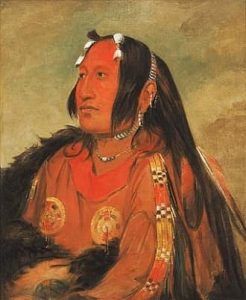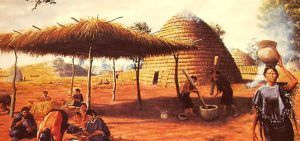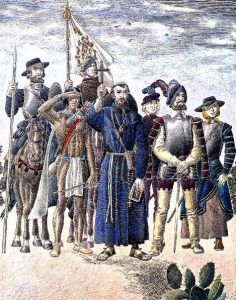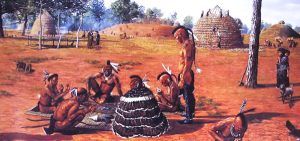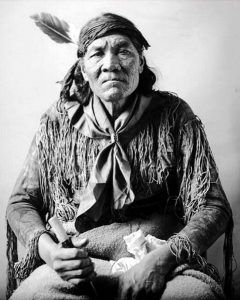The Caddo Nation is a confederacy of several Native American tribes who historically inhabited much of what is now East Texas, Louisiana, Arkansas, and Oklahoma. They were descendants of the Caddoan Mississippian culture that constructed huge earthwork mounds at several sites in this territory. Their name derives from a French truncation of kadohadacho, meaning “real chief” in Caddo.
The Caddoan language family is linguistically related to the Pawnee, Arikara, Wichita, and Kichai languages. Though each band of the Caddo had a distinct dialect, these dialects could generally be understood by all speakers of the Caddo language.
The Caddo is thought to have lived in this area of the south as early as 200 BC, and by the year 800 had begun to coalesce into the Caddoan Mississippian culture with some villages gaining prominence as ritual centers who built major earthworks, which served as temple mounds, platforms for residences of the elite, and burials. The temples and burial mounds were built around plazas that were used for ceremonial purposes. The mound-building flourished into the 13th century.
The Spiro Mounds, near the Arkansas River in present-day southeastern Oklahoma, were some of the most elaborate mounds in the United States. They were made by historic Caddo and Wichita tribes. Other mounds exist in Alto and Nacogdoches, Texas.
The Caddo had long been semi-sedentary agriculturalists with their villages surrounded by fields of corn, beans, pumpkins, squash, and grain-bearing grasses. They also cultivated tobacco, hunted small game, fished, and gathered fruits and nuts. The men of the tribes often went on buffalo hunts. The Caddo people who lived near saline marshes made salt by boiling brine in large shallow pans, which they traded with other tribes.
They lived in “beehive” style houses made of a framework of poles covered with thatched grass. These were generally grouped about an open space where social and ceremonial gatherings would be held. Food was cooked in vessels of pottery and baskets of varying sizes, which were skillfully made. Plant fibers were woven, and the cloth was made into garments. Other clothes were made from animal skins, including the buffalo, for winter use. Besides having the usual ornaments for the arms, neck, and ears, the Caddo often wore nose rings and practiced tattooing. Descent was traced through the mother, and chieftainship was hereditary, as was the custody of certain sacred articles used in religious ceremonies.
Centuries before extensive Europeans arrived, some of the Caddo territory was invaded by migrating Osage, Ponca, Omaha, and Kanza tribes, who moved west beginning about 1200 due to years of warfare with the Iroquois in the Ohio River area of present-day Kentucky. The Osage fought the Caddo, pushing them out of some former territory, and became dominant in the region of present-day Missouri, Arkansas, and eastern Kansas.
Cabeza de Vaca and his companions in 1535-36 traversed a portion of the territory occupied by the Caddo, and in 1542, Hernando de Soto’s expedition entered the region, finding thriving Caddo communities distributed along the Brazos, Trinity, Neches, Sabine, Red, and Ouachita Rivers. By the late 17th century, they numbered approximately 8,000 persons living in villages scattered along the Red River and its tributaries.
During the 18th century, the Spanish and the French were both contending for the territory occupied by the Caddo, and the brunt of these contentions fell upon the Indians. The trails between their villages became routes for armed forces, while the villages were transformed into garrisoned posts. The Caddo were initially friendly to the French, but they suffered greatly from contact with the white race. Tribal wars were fomented, villages were abandoned, new diseases spread havoc among the people, and by the close of the century, the welcoming attitude of the Indians changed to one of defense and distrust. Several tribes were practically extinct, others seriously reduced in numbers, and a once thrifty and numerous people had become demoralized and had become wanderers in their native land.
By 1790, the Arkansas Caddo, weakened by European epidemics and raids by the Osage, moved farther down the Red River, nearer French trade centers. The first American agent the Caddo dealt with was Major Stephen H. Long in 1818, who reported that the Caddo who “inhabited a part of the country before the cession of Louisiana to the United States… pretended to claim all the country.” The conclusive loss of Caddo homelands in Arkansas and Louisiana came in July 1835, when their headmen were coerced to sign a treaty ceding all Caddo land in the nation, never again to live there as a group. Caddo Chief Tashar, who supported the treaty, said:
“My Children: For what do you mourn? Are you not starving in the midst of this land? And do you not travel far from it in quest of food? The game we live on is going farther off, and the white man is coming near to u, and is not our condition getting worse daily? Then why lament for the loss of that which yields us nothing but misery? Let us be wise then, and get all we can for it, and not wait till the white man steals it away, little by little, and then gives us nothing.”
The treaty transferred about a million acres of land to the United States in exchange for $30,000 in goods and horses and $10,000 per year in cash for the next five years.
At that time, some Caddo moved into Oklahoma, some to Mexico, others joined the Choctaw tribe, and some moved to the Brazos River farther west in Texas. However, the people in Texas were contending for independence, and no tribe could live at peace with both opposing forces.
In 1843 the governor of the Republic of Texas sent a commission to the Caddo tribes to fix a line between them and the white settlers and to establish three trading posts. But, as the land laws of the republic did not recognize the Indian’s right of occupancy, there was no power that could prevent a settler from taking land that had been cultivated by an Indian. This condition led to continual difficulties, and these did not diminish after the annexation of Texas to the United States. Much suffering ensued as the fields of peaceable Indians were taken, and the more warlike tribes made reprisals. Making matters worse, as immigration increased, and the inroads on the buffalo herds by the newcomers made scarce the food of the Indians.
In 1854 a reservation on the Brazos River was set aside for the Caddo, and about 2,000 Indians, including the Anadarko, Waco, and Tonkawa, moved there. About 600 acres was put in cultivation, mostly in corn, wheat, vegetables, and melons. Most of the white settlers recognized and respected the reservation dwellers, and many of the Caddo worked as scouts for the Texas Rangers and military officers against other warring tribes. However, this pleased neither the anti-Indian white men nor the hostile Indians. Depredations of the Comanche in the area were often blamed on the reservation Indians, and by 1858 this antagonism verged on warfare. As a result, Texas politicians appealed to the federal government to move the Indians out of the state.
In July 1859, the Caddo were forced to march for 15 days to Washita River in Oklahoma, losing more than half of their stock and possessions along the way. They were placed on a reservation with the Wichita Indians.
During the Civil War, Caddoan Chief Quinahiwi signed a treaty with the Confederacy, and many Caddo fought for the South. Others, who remained loyal to the government, took refuge in Kansas, while some went even as far west as Colorado.
In 1872 the boundaries of their reservation were defined, and in 1902 every man, woman, and child received an allotment of land under the provisions of the severalty act of 1887. In 1904 they numbered 535.
Today, the Caddo Nation of Oklahoma is a federally recognized tribe with its capital at Binger, Oklahoma. The several Caddo dialects have converged into a single language. Today, there are nearly 5,000 enrolled members of the nation.
Bands of the Caddo include the Kadohadacho, Hainai, Anadarko, Nabedache, Nacogdoches, Natchitoches, Yatasi, Adai, Eyeish, Nakanawan, Imaha, and Yowani.
More Information:
Caddo Nation
PO Box 487
Binger, Oklahoma 73009
405-656-2345
© Kathy Weiser-Alexander, updated December 2022.
Also See:
Native Americans – The First Owners of America
Native American Photo Galleries
Sources:
Caddo Nation
Encyclopedia of Arkansas
Handbook of Texas
Hodge, Frederick Webb; The Handbook of American Indians North of Mexico, Bureau of American Ethnology, Government Printing Office. 1906.
Texas Beyond History
Wikipedia

